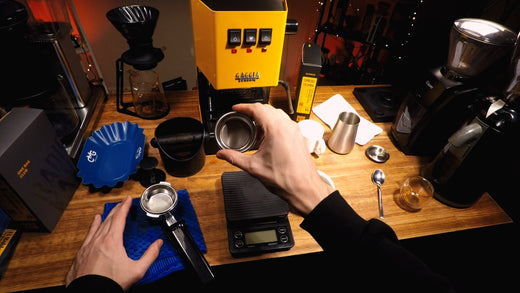
Moka Pot Coffee - 1 Cup Size - Reliable Recipe
Share
Moka pot coffee isn’t hard to make unless we talk about 1 cup size version. Though, with this knowledge it now will be way easier.
What exactly makes a moka pot 1 cup size the hardest one?
Firstly, there is not enough water to work with. And secondly, the amount is tiny for both coffee and water which requires high precision.
Problems with moka pot 1 cup size
- Coffee is cold (possibly because of fast heating and small amounts of water).
- Coffee is weak (because the grind size is to big or the dose it too small)
- Coffee is too bitter and intense (too much coffee and water was used)
In moka pot we have a lot of variables to play with and one affects the other. Which makes it even harder to find the perfect recipe. You can’t just change one parameter (usually) without affecting another.
Example: You have a balanced coffee, but want to make it more intense. You can’t just decrease the grind size. You also need to use less water to compensate for the faster extraction. And your final dose of coffee in the cup will be smaller as well.
The goal of the recipe
It’s designed with specialty coffee in mind in the first place. Medium roast (espresso). So that you can perceive the flavors that are mentioned on the coffee bag. If coffee is too intense it’ll be impossible to perceive them.
The recipe
Coffee: 8.3 g. Yes, that precise. Get some basic coffee / jewelry scale for precision.
Water: 60 g. Be consistent here as well. 5-10 g will change the flavor a lot.

Grind size: starting point as in the photo (smaller than sugar). But we will adjust it later by taste, because every coffee is different as well as coffee grinders.
On Kinu m47 coffee grinder I set 2.2 setting (two rotations and 2 numbers). It should be around 12 clicks on Comandante c40.
Add the water into the lower part. Pour the ground coffee into the basket and distribute it by tapping from the sides. Then - make a distribution by some flat object (drag the coffee to the areas where the level is lower. That way you will have an even resistance (more or less).

Assemble the brewer and place it on the heat. You can save some time by starting the stopwatch and using high heat output for 30-60 seconds just to heat up the water. Alternatively you can fill the moka pot with boiling water before assembling. But then switch to the low heat.
Brewing time
We need brewing time for around 33-45 seconds, not less. Adjust the power output of your stove so that it has such time from the moment when coffee appears to the bubbles at the end.

Always use the stopwatch to control this time. Otherwise you may get a weak cup. You can take it from the heat or lift over the flame to reduce the temperature and make the flow slower.
When to turn off the heat?
When the bubbles are not appearing in a single stream and start to go out in pulses. It’s the sign that there is no water left. Serve the coffee immediately and pour it out from the central column as well (if there is some coffee left).

As a result you should get 44 grams of beverage. Pretty hot, balanced and relatively intense.
How to adjust the grind size
We are targeting a balanced cup here with medium intensity. So that it’ll be pleasant to drink but it’ll not be “watery”.
If coffee is “weak” and “watery” - make the grind size smaller.
If coffee is “dark”, “intense” and the aftertaste is a “thick dark layer” - make the grind size bigger.
Explanation
We use this amount of coffee to have a proper resistance for water (otherwise we risk having weaker cup which could be simultaneously cold or even unbalanced).
When water contacts the coffee - it will expand. And we need to have time for it to expand so that the coffee will be clean and evenly extracted. When expanding, it will create this resistance for water. Especially if coffee is fresh (under 30 days after roasting). It will have CO2 gas in it which creates more resistance.
Why don't we add more coffee? First of all, it’ll increase the intensity. And also it will increase the resistance. Which will make the brewing temperature higher (water starts to flow up to the coffee at around 85°C. And when the resistance is high, the steam pressure in the lower part will raise, increasing the water temperature. Sometimes to over 100°C, like 109. And this may create a burnt flavor).
And with more coffee it’s very tricky to make even resistance within the coffee. We can compress it but risk getting channels (when water finds the smallest resistance and avoids other coffee).











